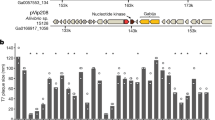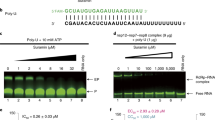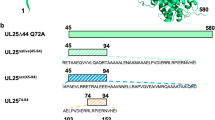Abstract
Molecules of the structure ppp(A2′p)2A containing a 2′→5′ phosphodiester bond, commonly abbreviated as 2-5A, are synthesized in interferon-treated virally-infected cells1 and have been implicated in several systems as contributing to interferon's antiviral activity2–7. The 2-5A binds to and subsequently activates an endogenous endonuclease, ultimately resulting in degradation of RNA 3–5,8–10. We have been interested in the use of 2-5A analogues to achieve antiviral activity without the use of interferon. For this approach to be successful, analogues must be synthesized with an increased stability (native 2-5A is rapidly degraded by cellular phosphodiesterases11–14) and with increased ability to enter intact cells. Removal of the highly-negative charged 5′ terminal phosphates from ppp(A2′p)2A results in formation of the ‘core’ species, (A2′p)2A, which should be able to penetrate intact cells more readily. While Kimchi et al. have shown that 2-5A core has an antimitogenic effect in mouse spleen lymphocytes15,16 and 3T3 fibroblasts17, Williams and Kerr have reported lack of antiviral activity against Semliki Forest virus or encephalomyocarditis virus by exogenously-administered 2-5A core3. We have previously determined that (xyloA2′p)2xyloA (abbreviated as xylo 2-5A core), the xyloadenosine analogue of the 5′-terminally dephosphorylated 2-5A core, is over 100 times more stable than the parent 2-5A core species18. We now report that this xylo 2-5A core inhibits replication of herpes simplex viruses 1 and 2 in vitro, with greater than 100 times the activity of the parent 2-5A core. The mechanism of antiviral action of the 2-5A core analogue appears to involve a pathway different from that activated by the parent 5′ triphosphorylated 2-5A species.
This is a preview of subscription content, access via your institution
Access options
Subscribe to this journal
Receive 51 print issues and online access
$199.00 per year
only $3.90 per issue
Buy this article
- Purchase on Springer Link
- Instant access to full article PDF
Prices may be subject to local taxes which are calculated during checkout
Similar content being viewed by others
References
Williams, B. R. G., Golgher, R. R., Brown, R. E., Gilbert, C. S. & Kerr, I. M. Nature 282, 582–586 (1979).
Williams, B. R. G., Golgher, R. R. & Kerr, I. M. FEBS Lett. 105, 47–52 (1979).
Williams, B. R. G. & Kerr, I. M. Nature 276, 88–90 (1978).
Eppstein, D. A. & Samuel, C. E. Virology 89, 240–251 (1978).
Baglioni, C., Minks, M. A. & Maroney, P. A. Nature 273, 684–687 (1978).
Nilsen, T. W., Wood, D. L. & Baglioni, C. Nature 286, 176–180 (1980).
Nilsen, T. W., Maroney, P. A. & Baglioni, C. J. Virol. 42, 1039–1045 (1982).
Ratner, L. et al. Biochem. biophys. Res. Commun. 81, 947–954 (1978).
Clemens, M. J. & Williams, B. R. G. Cell 13, 565–572 (1978).
Ball, L. A. & White, C. N. Virology 93, 348–356 (1979).
Eppstein, D. A., Peterson, T. C. & Samuel, C. E. Virology 98, 9–19 (1979).
Minks, M. A., Benvin, S., Maroney, P. A. & Baglioni, C. Nucleic Acids Res. 6, 767–780 (1979).
Williams, B. R. G., Kerr, I. M., Gilbert, C. S., White, C. N. & Bail, L. A. Eur. J. Biochem. 92, 455–462 (1978).
Schmidt, A. et al. Proc. natn. Acad. Sci. U.S.A. 76, 4788–4792 (1979).
Kimchi, A., Shure, H. & Revel, M. Nature 282, 849–851 (1979).
Kimchi, A., Shure, H. & Revel, M. Eur. J. Biochem. 114, 5–10 (1981).
Kimchi, A. et al. FEBS Lett. 134, 212–216 (1981).
Eppstein, D. A. et al. J. biol. Chem. 257, 13390–13397 (1982).
Gosselin, G. & Imbach, J. L. Tetrahedron Lett. 22, 4699–4702 (1981).
De Clercq, E. et al. J. infect. Dis. 141, 563–574 (1980).
Elion, G. B. et al. Proc. natn. Acd. Sci. U.S.A. 74, 5716–5720 (1977).
De Rudder, J., Andreeff, F. & De Garilhe, M. P. C. r. hébd. Seanc. Acad. Sci., Paris 264D, 677–680 (1967).
Author information
Authors and Affiliations
Rights and permissions
About this article
Cite this article
Eppstein, D., Barnett, J., Marsh, Y. et al. Xyloadenosine analogue of (A2′p)2A inhibits replication of herpes simplex viruses 1 and 2. Nature 302, 723–724 (1983). https://doi.org/10.1038/302723a0
Received:
Accepted:
Published:
Issue Date:
DOI: https://doi.org/10.1038/302723a0
This article is cited by
Comments
By submitting a comment you agree to abide by our Terms and Community Guidelines. If you find something abusive or that does not comply with our terms or guidelines please flag it as inappropriate.



